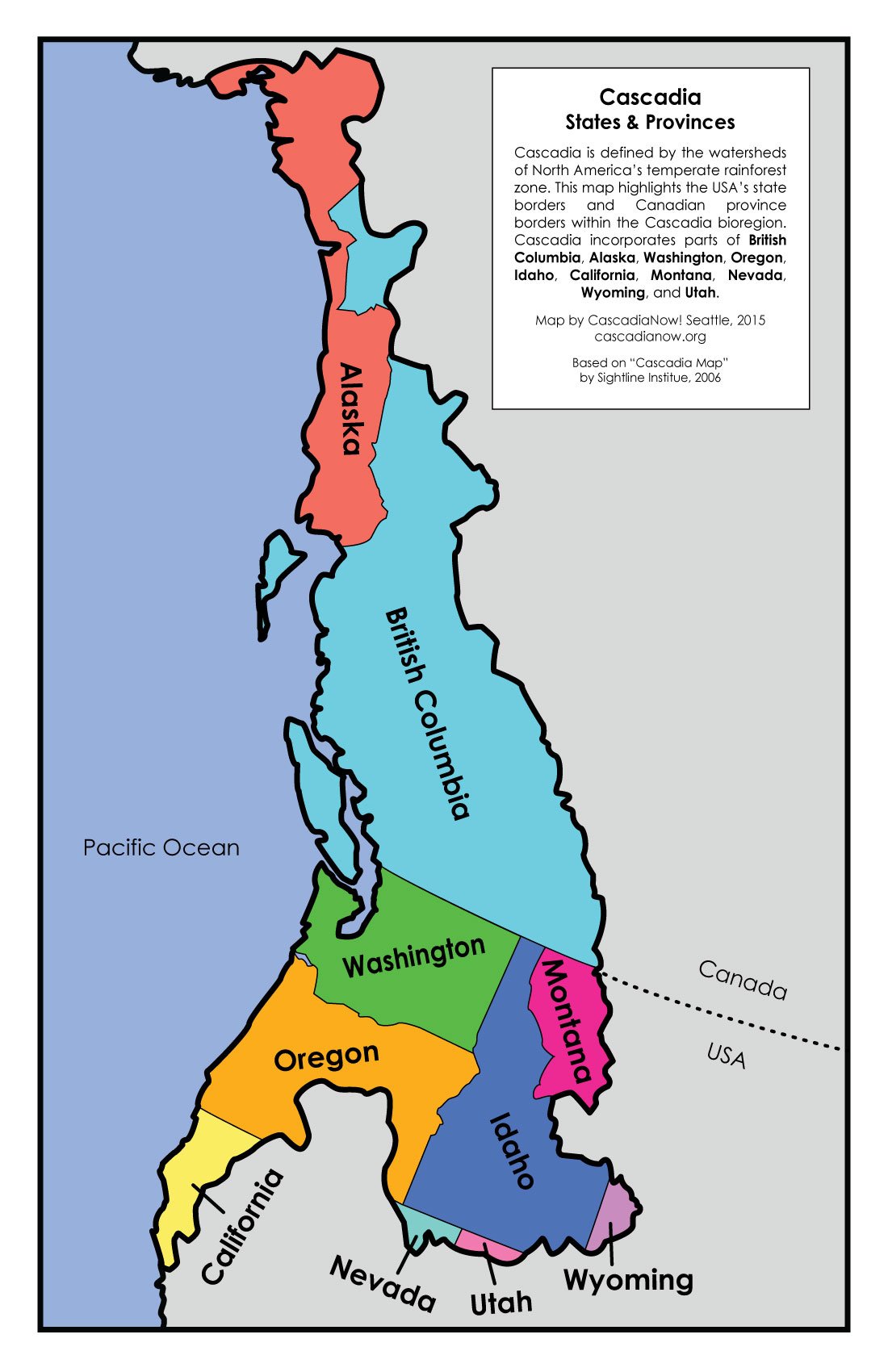Cascadia & Bioregionalism
Cascadia: a term that means many things to different people.
Cascadia is a bioregion. Cascadia defines the Pacific Northwest of the United States and Canada, incorporating British Columbia, Washington, Oregon, parts of Idaho, southern Alaska and northern California through the watersheds of the Columbia, Fraser and Snake River valleys. In many ways, it is geographically, culturally, economically and environmentally distinct from surrounding regions and has unique flora and fauna, topography, and geology. These natural, geographical borders create the Cascadia bioregion.
What is a bioregion? A bioregion is defined in terms of the unique overall pattern of natural characteristics that are found in a specific place. The main features are generally obvious throughout a continuous geographic terrain and include a particular climate, local aspects of seasons, landforms, watersheds, soils, and native plants and animals. People are also counted as an integral aspect of a place's life, as can be seen in the ecologically adaptive cultures of early inhabitants, and in the activities of present day reinhabitants who attempt to harmonize in a sustainable way with the place where they live (© 2002 Peter Berg, Planet Drum Foundation)
Where did contemporary bioregionalism come from? In the early 1970s, the contemporary vision of bioregionalism began to be formed through collaboration between natural scientists, social and environmental activists, artists and writers, community leaders, and back-to-the-landers who worked directly with natural resources. They wanted to do "more than just save what's left" in regard to nature, wildness and the biosphere. Planet Drum Foundation in San Francisco became a voice for this sentiment through its publications about applying place-based ideas to environmental practices, society, cultural expressions, philosophy, politics, and other subjects. By the late 70s, bioregional organizations such as the Frisco Bay Mussel Group in northern California and Ozark Area Community Congress on the Kansas-Missouri border were founded to articulate local economic, social, political, and cultural agendas. The Mussel Group eventually played a pivotal role in persuading the public to vote down a bioregionally lethal Peripheral Canal proposal to divert fresh water away from San Francisco Bay. The Ozarks group has held continuous annual gatherings to promote and support place-based activities. At present there are hundreds of similar groups (and publications) in North and South America, Europe, Japan, and Australia (© 2002 Peter Berg, Planet Drum Foundation)
What does bioregional thinking look like? Peter Berg from the Planet Drum Foundation cites, "There is a strong affinity for bioregional thinking in many fields that relate to ecological sustainability. Restoration ecology practitioners readily grasp the importance of an appreciative local culture for their efforts to revive native plants and animals. Urban ecology advocates use bioregions for "nesting" their redesigned cities in a broad natural context. Permaculturalists and most organic farmers employ techniques that are appropriate to their particular locales and insist on maintaining soils, water sources, and native species. Poets, painters, theater groups, and other artists have embraced bioregional themes in their works. Grade school teachers introduce bioregional concepts, and graduate schools recognize theses and dissertations based on them. Followers of Deep Ecology claim bioregionalists as a social manifestation of their biocentric philosophy. Even traditional conservation and environmental groups including the Sierra Club have subsequent to the inception of bioregionalism adopted a system of"ecoregions" to address members' problems in home areas" (© 2002 Peter Berg, Planet Drum Foundation)
What does Cascadian bioregionalism look like? Cascadian bioregionalism deals with the connected ecological, environmental, economic and cultural ties that are prevalent throughout the Pacific Northwest. Those in Washington and Oregon have much in common with those in British Columbia despite being of different nationalities. As we continue into a more global age, and as efforts to create integrated transportation and economic systems, stem pollution and global warming, and support sustainable alternatives increasingly requires the commitment of larger regional players.
Cascadia as place-based action: Cascadia and bioregionalism seeks to further local autonomy, empower individuals and communities to better represent their own needs, and create sustainable local economies through bioregional planning. Bioregionalism encourages people to think bioregionally (and therefore, locally), by looking for ways to create community resilience and a alternate lines of regional communication, politics, and interdependence that better represent the natural boundaries that define the Pacific Northwest.
The term Cascadia is also used to define a unique regional character found within the Pacific Northwest, and extends to a wide range of beers (Cascadia Dark Ale), sports (the Cascadia Cup) and music (Cascadian Black Metal) just to name a few. The idea has since been adopted by a wide range of researchers who highlight the growing importance of regional growth management, environmental planning, economic cooperation, as well as disaster preparedness. Support for the idea also comes from institutions and businesses such as the Bullit Foundations 'Cascadia Center', the adoption of the Cascadia Megaregion by federal policy makers, and the tectonic Cascadia Subduction Zone.
So what is CascadiaNow? CascadiaNow! is a 501(c)3 non-profit organization that supports acting locally. We cultivate all of the awesomeness of Cascadia NOW through support of our grassroots projects and program volunteers. Our organization raises awareness of, and educates about bioregionalism, Cascadia, by serving as an umbrella non-profit for a wide range of community-based projects.



